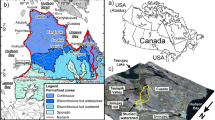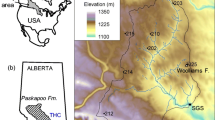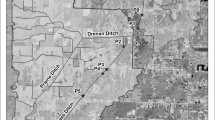Abstract
Persistently wet conditions are essential to prevent the decomposition of organic material that forms peatlands. Wetlands in areas with a snow-melt dominated precipitation regime and little or no summer precipitation often rely on groundwater to meet late-season water requirements. Past and predicted changes in climate for the Sierra Nevada show a trend towards more winter precipitation falling as rain rather than snow. This is expected to result in reduced late-season water availability and the subsequent degradation of peatlands. Measurements of groundwater levels, stream flow, specific conductance, and peat water retention characteristics are used to quantify aspects of the hydrologic system that supports Grass Lake, south of Lake Tahoe California, the largest peatland in the Sierra Nevada. Water budget calculations using periodic measurements collected throughout the growing season show that groundwater discharge is a significant component of the water balance in the late-summer and fall. Late-season evapotranspiration needs were approximately balanced by groundwater inflow for 2010 (average water year). Groundwater discharge to the peatland dominated the late-season water budget in 2011 (above average water year) and persisted into October. Water retention experiments and field data suggest desaturation of the peatland accounts for approximately 0.5 mm day−1, or roughly 10 % of the estimated evapotranspiration rate.







Similar content being viewed by others
References
Armin RA, John DA, Dohrenwend JC (1983) Geologic map of the Freel Peak 15-minute quadrangle. United States Geological Survey, California
Arnold C, Ghezzehei T, Berhe A (2014) Early spring, severe frost events, and drought induce rapid carbon loss in high elevation meadows. PLoS One 9(9):e106058. doi:10.1371/journal.pone.0106058
Berg KS (1991) Establishment record for Grass Lake Research Natural Area within Eldorado National Forest, managed in Lake Tahoe Basin Management Unit, in El Dorado County, California. Pacific Southwest Research Station, Albany, California, Unpublished report on file
Boelter DH (1964) Water storage characteristics of several peats in situ. Soil Sci Soc Am J 28:433–435. doi:10.2136/sssaj1964.03615995002800030039x
Burke MT (1987) Biological survey of Grass Lake candidate Research Natural Area. University Arboretum, University of California, Davis, California
Cayan D, Maurer E, Dettinger M, Tyree M, Hayhoe K (2008) Climate change scenarios for the California region. Clim Change 87:21–42. doi:10.1007/s10584-007-9377-6
Christensen W (2013) Hydrologic characterization and modeling of a Montane peatland, Lake Tahoe Basin, California. University of California, Davis
Comer NT, Lafleur PM, Roulet NT, Letts MG, Skarupa M, Verseghy DL (2000) A test of the Canadian land surface scheme (class) for a variety of wetland types. Atmos Ocean 38:161–179
Cooper DJ, Wolf EC (2006a) Fens of the Sierra Nevada, California. Department of Forest, Rangeland and Watershed Stewardship, Colorado State University, Fort Collins, Colorado
Cooper DJ, Wolf EC (2006b) The influence of groundwater pumping on wetlands in Crane Flat, Yosemite National Park, California
Dasberg S, Neuman SP (1977) Peat hydrology in the Hula Basin, Israel: i. properties of peat. J Hydrol 32:219–239
Dettinger MD, Cayan DR, Meyer MK, Jeton AE (2004) Simulated hydrologic response to climate variations and change in the Merced, Carson, and American River basins, Sierra Nevada, California, 1900–2099. Clim Change 62:283–317
Fetter CW (2001) Applied hydrogeology, 4th edn. Prentice-Hall Inc, Upper Saddle River
Green CT (1998) Integrated studies of hydrogeology and ecology of Pope Marsh, Lake Tahoe. University of California, Davis
Hill BR (1990) Groundwater discharge to a headwater valley, northwestern Nevada, U.S.A. J Hydrol 113:265–283
Kondolf MG, Piegay H (2002) Tools in fluvial geomorphology. Wiley, West Sussex
Loheide SPI, Gorelick SM (2005) A local-scale, high-resolution evapotranspiration mapping algorithm (ETMA) with hydroecological applications at riparian meadow restoration sites. Remote Sens Environ 98:182–200
Matthews E, Fung I (1987) Methane emission from natural wetlands: global distribution, area, and environmental charactersists of sources. Glob Biogeochem Cycles 1:61–68
Mitsch WJ, Gosselink JG (1993) Wetlands, 2nd edn. Van Nostrand Reinhold, New York
PRISM (2013) PRISM climate group. Oregon State University. http://www.prism.oregonstate.edu. Accessed 20 Jan 2013
Rood DH, Burbank DW, Finkel RC (2011) Chronology of glaciations in the Sierra Nevada, California, from 10 Be surface exposure dating. Quatern Sci Rev 30:646–661
Silins U, Rothwell RL (1998) Forest peatland drainage and subsidence affect soil water retention and transport properties in an Alberta peatland. Soil Sci Soc Am J 62:1048–1056
Soil Survey Staff (1999) Soil taxonomy: a basic system of soil classification for making and interpreting soil surveys, 2nd edn. Natural Resources Conservation Service, U.S. Department of Agriculture Handbook 436
Stanek W, Silc T (1977) Comparison of four methods for determination of degree of peat humification (decomposition) with emphasis on the von Post method. Can J Soil Sci 57:109–117
TRPA (2012) Lake Tahoe Basin LiDAR. OpenTopography. http://www.opentopography.org/index.php/blog/detail/tahoe_lidar_imagery_in_google_earth. Accessed 15 Aug 2012
Twidale CR, Vidal Romani JR (2005) Landforms and geology of granite terrains. Taylor & Francis Group, London
USDA (1988) Establishment Record for Grass Lake Research Natural Area. U.S. Government Printing Office, El Dorado National Forest
USDA (1999) Soil Taxonomy: a basic system of soil classification for making and interpreting soil surveys, Second, 2nd edn. U.S. Government Printing Office, Washington, DC
Weiss R, Alm J, Laiho R, Laine J (1998) Modeling moisture retention in peat soils. Soil Sci Soc Am J 62:305–313
Acknowledgments
This research was supported by an agreement from the USDA Forest Service Pacific Southwest Research Station. This research was supported using funds provided by the Bureau of Land Management through the sale of public lands as authorized by the Southern Nevada Public Land Management Act. We are grateful to the following people for their assistance with field work: Sherry Devenberg, Ida Fischer, Shana Gross, Sarah Howell, and Sue Norman. We would like to thank Doug Clark for discussions about the geology of the area and the reviewers for their comments which helped improve this manuscript.
Author information
Authors and Affiliations
Corresponding author
Rights and permissions
About this article
Cite this article
Kitlasten, W., Fogg, G.E. Hydrogeology of a groundwater sustained montane peatland: Grass Lake, California. Wetlands Ecol Manage 23, 827–843 (2015). https://doi.org/10.1007/s11273-015-9422-6
Received:
Accepted:
Published:
Issue Date:
DOI: https://doi.org/10.1007/s11273-015-9422-6




